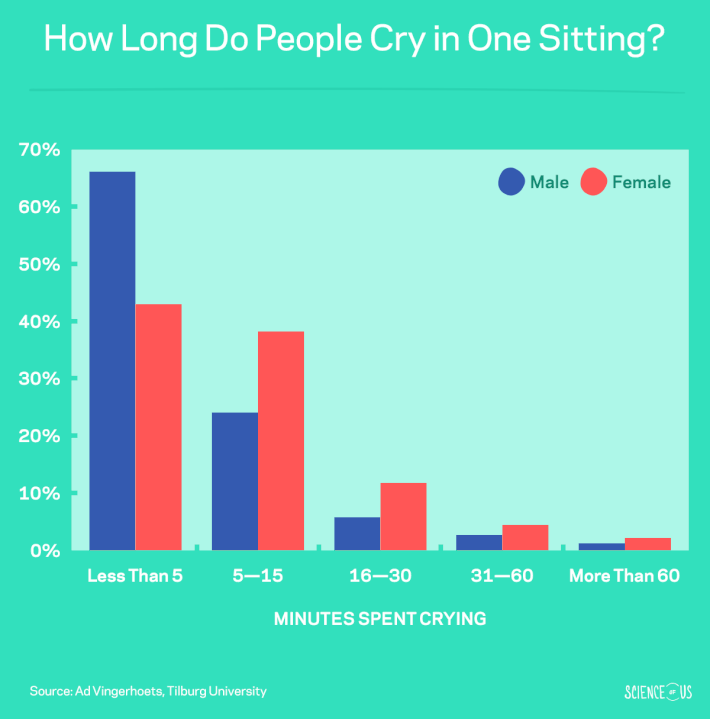
I cry incredibly, embarrassingly easily. When I was maid of honor at my best friend’s wedding last summer, I burst into tears the minute I started walking down the aisle. That’s understandable, but I also cry at smaller, stupider things: during nearly every distance-running race I’ve ever participated in, for instance, or at that Apple ad about the girl who makes the sweet DIY duet for her grandmother.
Crying and me, we are very comfortable with one another, and I always assumed this was mostly owing to reasons best explained by psychology, maybe also a little therapy, and possibly my gender. But a recent, lengthy email exchange with “leading tear researcher” Ad Vingerhoets pointed me toward a simpler yet weirder explanation: Maybe I just have really shallow tear ducts, which are more quickly filled up and spilled over. This appears to be the case for most women when compared to men, and maybe this, plus some relevant hormonal changes that happen around puberty, is part of a physiological explanation as to why men tend to cry less often than women.
Vingerhoets is a clinical psychologist at Tilburg University and the author of the book Why Only Humans Weep: Unravelling the Mysteries of Tears; he’s also one of the few researchers out there currently studying emotional tears — those triggered by feelings rather than, say, onions or other irritants. His work suggests that the stereotype about women crying more is true: Women cry 30 to 64 times a year, whereas men cry just 6 to 17 times per year. (Or they say they do, at least. Much of this research relies on self-reporting, which means men could be underreporting how much they tear up. But Vingerhoets’s estimate is in line with past research conducted by others — although that was also self-reported.)
Vingerhoets has also studied the average length of time a crying bout lasts (again, based on self-reports). He surveyed more than 5,000 young adults from about three dozen countries, and found that women say they usually cry for six minutes at a time, on average; men, on the other hand, say they cry about two to three minutes on average. He shared the results of that survey with me in an email:

We can intuit that men cry less often than women owing to social conditioning; crying doesn’t really fit in with our image of stereotypical manhood, after all, and that’s no doubt a partial explanation of why men are more likely to hold in their tears. But men may also be biologically built to shed fewer tears, Vingerhoets and other experts suggest.
Back to the tear ducts, for example. “There are several studies over the years that have shown that men have larger tear ducts in their eyes, so that it is less likely for the tears to well up to the point of spilling over the eyelid onto the cheek,” said Dr. Geoffrey Goodfellow, an associate professor at the Illinois College of Optometry in Chicago. There’s also this paper from the 1960s, in which a physician from the University of Michigan reports how he used male and female skulls to measure the length and depth of tear ducts, finding that women’s were shorter and shallower.
Hormones also may provide an explanation, too, including testosterone, which, Vingerhoets believes, inhibits crying. Male prostate cancer patients, for example, tend to become more emotional when treated with medications that lower their testosterone levels. But this isn’t just about testosterone: Back in the 1980s, biochemist William H. Frey and his team analyzed the chemical makeup of emotional tears and compared them to tears caused by irritants. They found, among other things, that emotional tears tend to contain prolactin, a hormone produced by the pituitary gland that is associated with emotion. Vingerhoets passed on a 2012 paper from a team of Nigerian scientists that he said may help connect this to the gender difference in crying.
From the paper:
[A]dult women have serum prolactin levels almost sixty percent above the average male. This difference may help to explain why women as a whole cry more frequently … . Before puberty, the serum prolactin levels are the same in both sexes, and studies have found that the crying level of boys and girls is much more similar before puberty.
Lauren Bylsma, an associate professor in psychiatry at the University of Pittsburgh who has studied crying with Vingerhoets, said that this difference in prolactin levels “may help explain these differences in crying, as well as other differences in emotional expression and depression vulnerability between men and women.” Next time I find myself crying over something that is maybe not entirely worthy of tears, I hope I will manage to blurt out something about prolactin! and tiny tear ducts! in between sobs.




